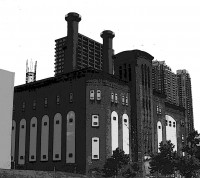Stabilization of  Jersey City  Powerhouse Moves Forward
Â
By Sally Deering
Â
 The Hudson & Manhattan RR Powerhouse in the downtown section of Jersey City stands amidst the million-dollar high-rises like a drab Cinderella before her Fairy Godmother turns her into a Princess. An icon of the golden age of Jersey City, the H&M Powerhouse that once harnessed electrical power to the Hudson Trains and Tunnel that connected New Jersey and New York before the PATH is now a deconstructed shell of her former self and – just like Cinderella – about to receive a makeover.
The Hudson & Manhattan RR Powerhouse in the downtown section of Jersey City stands amidst the million-dollar high-rises like a drab Cinderella before her Fairy Godmother turns her into a Princess. An icon of the golden age of Jersey City, the H&M Powerhouse that once harnessed electrical power to the Hudson Trains and Tunnel that connected New Jersey and New York before the PATH is now a deconstructed shell of her former self and – just like Cinderella – about to receive a makeover.
Â
Located on Washington Boulevard between First and Bay Streets in downtown Jersey City, the H & M Powerhouse is in the city’s Warehouse Historic District on the National Register of Historic Places.  Designed by architect John Oakman and his partner W. Powell Robins, the H & M Powerhouse began powering up H & M Railroad’s Hudson Tunnels subway line that connected New Jersey and New York on February 25, 1908. It provided power 24/7 to the cars, lines, stations and terminals here and in New York.  In 1929 the H & M Powerhouse closed and in December 2001, the National Register of Historic Places certified it as a national landmark. The Port Authority and Jersey City jointly own the building and in 2009 agreed to the stabilization of the Powerhouse which has now become the anchor for the Powerhouse Arts District – a proposed mecca of theaters, art galleries, restaurants and shops. According to Bob Antonicello, Executive Director of the Jersey City Redevelopment Authority which oversees new and reconstructed building development in Jersey City, the ongoing stabilization of the historic H & M Powerhouse by the JCRA has entered a critical stage with the removal of the building’s smokestacks.
 “Unfortunately, the removal of the smokestacks is something that is unavoidable,†Antonicello says. “The years of deterioration have undermined the stability of the stacks and after exhaustive engineering studies, including invasive testing last spring, have led to the conclusion that the smokestacks could not be saved.â€
The removal began the last week of March and will take approximately six weeks.
“Although we are saddened to see the smokestacks removed, we are encouraged by the fact that the building has been stabilized,†Antonicello says. “We are now moving forward with the designated redeveloper, the Cordish Companies of Baltimore, Maryland, with the future plans which will include the reconstruction of the smokestacks.â€
Jersey City Mayor Jerramiah T. Healy says that although he was disappointed when he learned that the smokestacks would have to come down, he is encouraged by the hard work the JCRA is doing to preserve “the historic treasure of our City’s industrial past.â€
“I know, like the Power Plant in Baltimore, this property will see a rebirth that will be a lynchpin for the Powerhouse Arts District and a landmark for the City,†Healy says.
For more information on the history of the H&M Powerhouse, visit: www.njcu.edu; www.jerseycitylandmarks.org
Â
